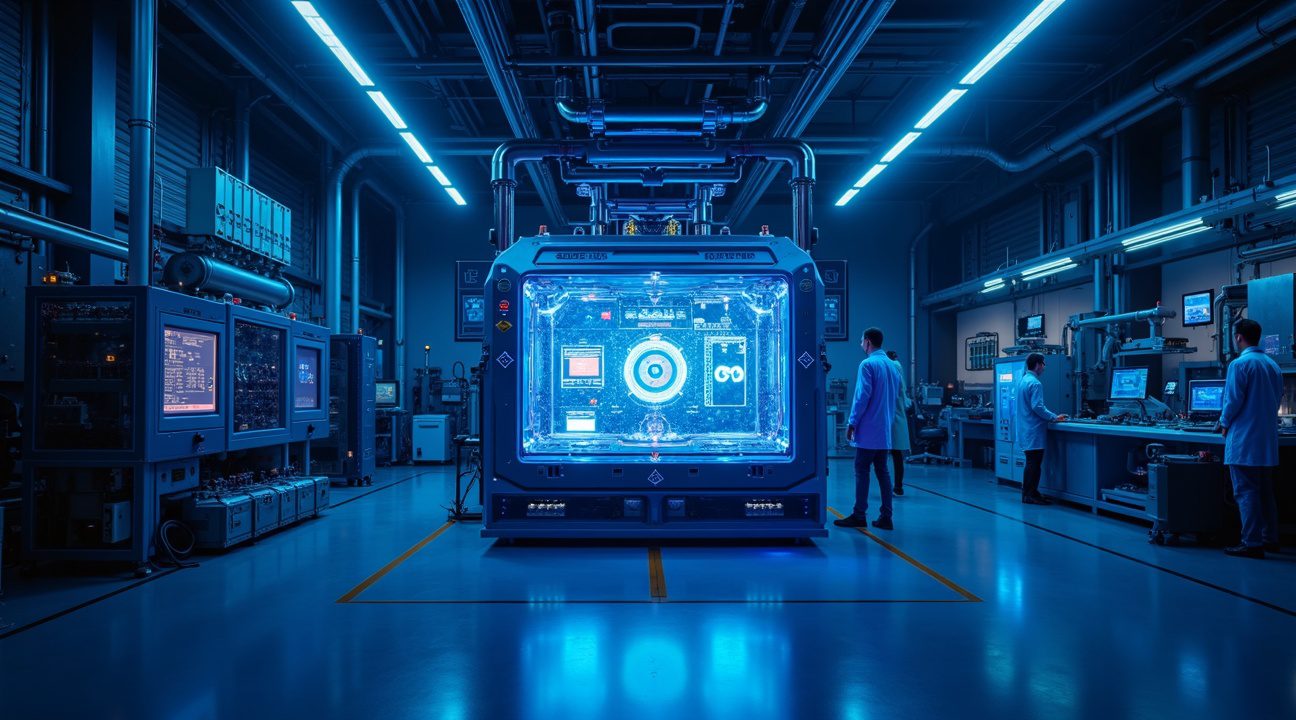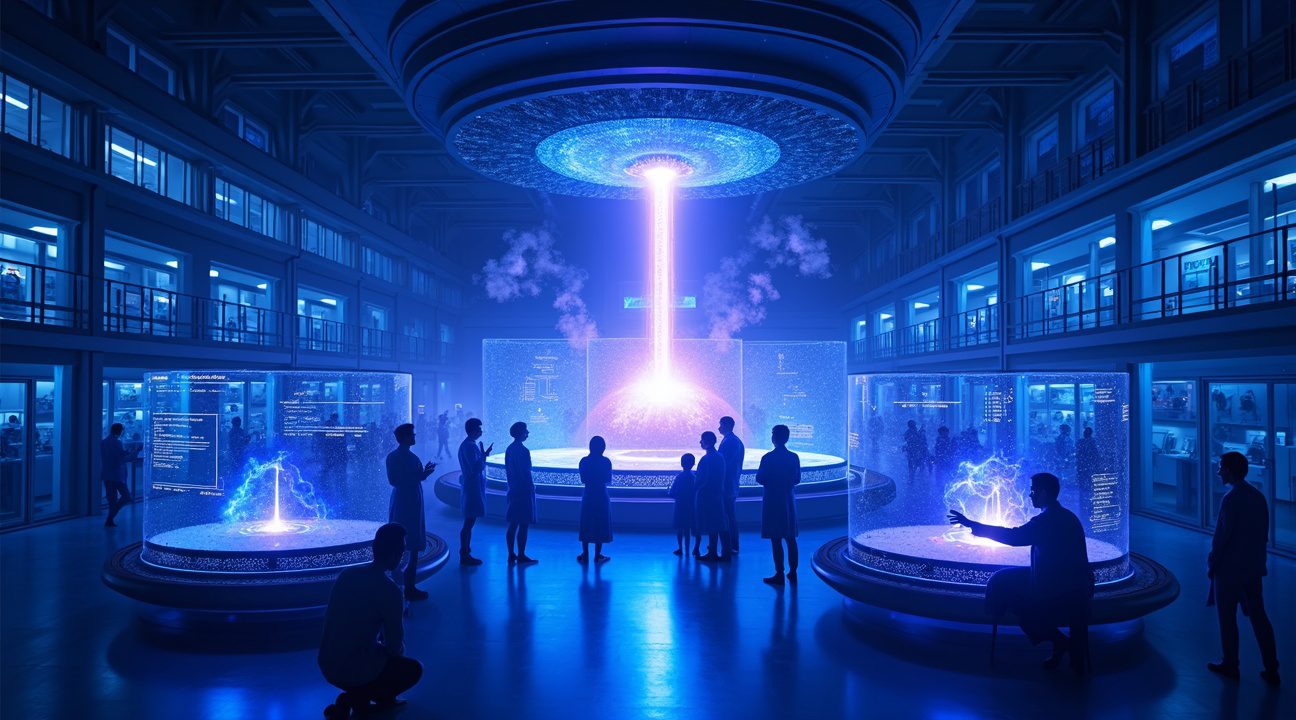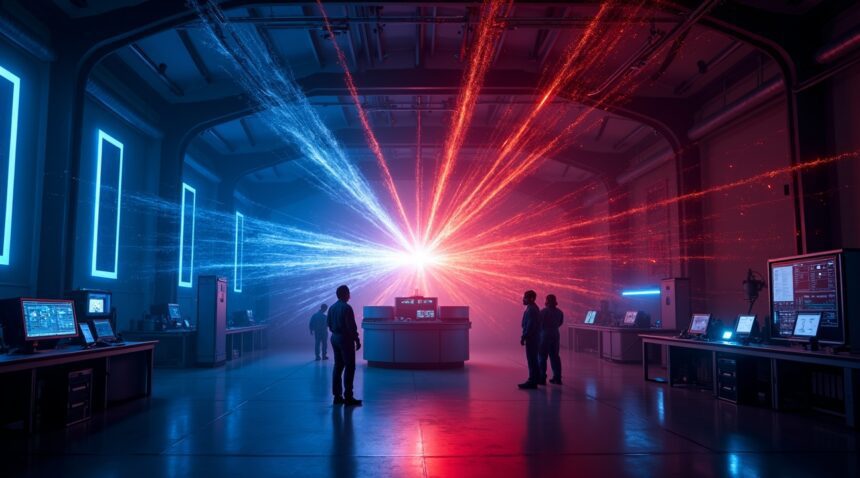ZEUS Laser Reaches 2-Petawatt Milestone, Becomes America’s Most Powerful Laser
The University of Michigan’s ZEUS laser system has achieved a historic milestone by firing its first 2-petawatt pulse, making it America’s most powerful laser and significantly expanding research horizons in high-energy physics and cancer treatment.
Key Takeaways
- ZEUS generates 2 petawatts of power (2 quadrillion watts) in ultrashort 25-femtosecond pulses, momentarily exceeding the global electricity supply by over 100 times during its operation.
- The laser replicates extreme cosmic environments like those near black holes and neutron stars via plasma wakefield acceleration, allowing in-lab study of otherwise inaccessible physics phenomena.
- Medical applications include precise cancer therapy that targets malignant cells while preserving healthy tissue, as well as advanced soft tissue imaging surpassing traditional X-ray methods.
- ZEUS operates as an international research hub, welcoming global scientists through open-access proposal submissions for a wide range of high-intensity laser applications.
- The system is on track for a 3-petawatt upgrade, reinforcing America’s lead in laser science and encouraging international collaborative research projects.
Unleashing New Possibilities in Physics
The ZEUS laser is more than a record-breaking device—it’s a window into the universe’s most extreme conditions. Its unparalleled power enables researchers to recreate and study phenomena previously limited to distant astrophysical environments or abstract simulations. For example, conditions near neutron stars or black hole event horizons can now be mimicked in controlled lab settings, facilitating quantum-level insights into matter and energy interactions.
Femtosecond Pulses with Planetary Scale Impact
Each pulse from ZEUS lasts only 25 femtoseconds—a unit of time so short that light itself travels less than the width of a human hair during the pulse. In those fleeting moments, the laser discharges more power than is generated by the entire global electric grid, concentrated in microscopic regions for maximum effect and minimal waste.
Global Research Access and Applications
Scientists from around the world are actively submitting proposals to utilize the ZEUS laser across diverse experimental disciplines. These range from particle physics to materials science to fusion energy research. The laser’s versatility is empowering innovations like enhanced imaging techniques, which could dramatically improve early medical diagnoses through more accurate soft tissue visualization.
Revolutionizing Cancer Treatment
Of all its applications, ZEUS’s medical impact might be the most transformative. Unlike traditional radiation therapies that risk damaging healthy tissue, ZEUS offers the promise of cellular-level precision. Early studies show it may effectively destroy tumors while preserving nearby organs—an approach that could drastically reduce treatment side effects and improve patient outcomes.
International Collaborations and the Future of ZEUS
Thanks to its open-access model, the ZEUS facility is fostering worldwide collaboration. Research institutions throughout Europe and Asia are already engaged in joint projects, establishing the University of Michigan’s facility as a central hub for groundbreaking discoveries. This international approach ensures that ZEUS’s full scientific potential benefits not just American research but the global community.
Path Forward: Upgrading to 3 Petawatts
Plans are underway to upgrade ZEUS to a staggering 3 petawatts, a move that will further solidify the U.S. leadership position in high-intensity laser technology. Once completed, the enhanced system will unlock even more experimental possibilities, from deeper study of fundamental forces to real-world medical innovations. The current upgrade timeline suggests the new capability will be available within two years, opening a new chapter in the era of ultrahigh-power lasers.
ZEUS Laser Fires Historic 2-Petawatt Pulse, Creating America’s Most Powerful Laser
The University of Michigan’s ZEUS laser system has achieved a groundbreaking milestone, firing its first 2-petawatt pulse and officially claiming the title of America’s most powerful laser. This achievement represents a dramatic leap forward, surpassing previous U.S. laser capabilities by a factor of two and establishing new frontiers in high-energy physics research.
Understanding the sheer magnitude of ZEUS’s power output requires grasping some extraordinary numbers. A petawatt equals 1 quadrillion watts, making ZEUS’s 2-petawatt capacity equivalent to 2 quadrillion watts of raw energy. For context, this peak output exceeds the entire global electricity supply by more than 100 times, though this incredible power pulse lasts just 25 femtoseconds—or 25 quintillionths of a second.
The acronym ZEUS stands for Zettawatt Equivalent Ultrashort laser pulse System, reflecting the facility’s ambitious design goals and its potential for even greater power outputs in the future. This femtosecond pulse duration represents one of the most remarkable aspects of the system, concentrating astronomical amounts of energy into timeframes that challenge human comprehension.
Opening Doors for Global Scientific Collaboration
The U.S. National Science Foundation backs this revolutionary facility, positioning ZEUS as an open-access user facility that welcomes researchers from institutions worldwide. Scientists can submit experimental proposals to access this unprecedented tool, democratizing access to extreme laser physics capabilities. This approach mirrors successful models seen in other scientific endeavors, such as how SpaceX launches have opened new possibilities for space research collaboration.
Research teams can now explore physics phenomena that were previously impossible to recreate in laboratory settings, from studying matter under extreme conditions to investigating fundamental particle interactions. The facility’s collaborative model ensures that breakthrough discoveries won’t be limited to a single institution but can benefit the entire scientific community.
ZEUS’s achievement comes at a time when laser technology continues pushing boundaries in unexpected ways. Just as researchers have developed innovative robotic systems that can adapt to extreme conditions, this laser system adapts electromagnetic energy to create conditions found nowhere else on Earth except in the most extreme cosmic environments.
The implications of this power level extend far beyond simple records. Scientists can now recreate conditions similar to those found in stellar cores, black hole accretion disks, and other cosmic extremes, potentially unlocking secrets about fundamental physics that have remained hidden for centuries.
Recreating Cosmic Extremes Through Laboratory Physics
ZEUS represents a groundbreaking achievement in bringing the most extreme conditions in the universe into controlled laboratory settings. I find it fascinating how this laser system can recreate environments analogous to those found around neutron stars and black hole event horizons—conditions so extreme they were previously impossible to study directly on Earth.
The laser’s remarkable capability stems from its ability to generate collisions between high-speed electron beams and counter-propagating petawatt laser pulses. These interactions simulate energy conditions equivalent to a zettawatt, which equals 1021 watts—a power scale that dwarfs anything previously achieved in laboratory physics. Scientists have advanced space exploration through technological innovations, and ZEUS continues this tradition of pushing boundaries in experimental physics.
Plasma Wakefield Acceleration: The Key Technology
ZEUS accomplishes these extraordinary energy levels through plasma wakefield acceleration, a technique that accelerates electrons to incredible speeds using plasma waves. This method enables energy levels comparable to those generated by massive particle accelerators, but in a much more compact system. The process begins when ZEUS targets helium gas with infrared pulses, creating plasmas that serve as the foundation for generating high-energy electron beams.
The laser’s initial experimental phase focuses on several key objectives:
- Producing compact, high-energy electron beams through controlled plasma interactions
- Achieving particle acceleration rates that rival traditional accelerator facilities
- Creating reproducible cosmic-level energy conditions for systematic study
- Developing new methodologies for quantum physics and plasma physics research
These experiments promise breakthroughs across multiple scientific disciplines. The ability to recreate cosmic extremes in controlled conditions opens unprecedented opportunities for studying quantum effects under extreme field strengths, investigating plasma behavior at previously unattainable energy densities, and advancing particle acceleration techniques.
The implications extend far beyond basic research. Scientists working on projects like space exploration missions could benefit from these advances in understanding extreme physics. The compact nature of ZEUS’s plasma wakefield acceleration could revolutionize how we approach particle physics experiments, potentially making high-energy research more accessible to institutions worldwide.
I’m particularly impressed by ZEUS’s potential to bridge the gap between theoretical astrophysics and experimental validation. Previously, scientists could only observe cosmic extremes from vast distances or rely on computer simulations. Now, they can create and study these conditions directly, testing theories about neutron star magnetospheres, relativistic jet formation, and the physics of matter under extreme gravitational fields.
The zettawatt equivalent power levels achieved through these experiments represent more than just impressive numbers—they provide access to physical regimes where new phenomena emerge. At these energy scales, scientists expect to observe quantum electrodynamic effects that are typically masked by weaker field strengths, potentially revealing new insights into the fundamental nature of matter and energy.
ZEUS’s experimental design allows for precise control over the interaction parameters, enabling systematic studies of how matter behaves under progressively extreme conditions. This controlled approach contrasts sharply with astronomical observations, where scientists must work with whatever conditions nature provides. The laser’s capability to recreate specific cosmic environments on demand transforms astrophysics from a purely observational science into an experimental one.
The technological innovations driving ZEUS also contribute to broader scientific advancement. Much like how robotic technologies have evolved to tackle complex challenges, the plasma wakefield acceleration techniques developed for ZEUS could find applications in fields ranging from materials science to medical technology. These cross-disciplinary benefits often prove as valuable as the primary research objectives themselves.
Revolutionary Medical Applications: Cancer Treatment and Advanced Imaging
ZEUS laser technology represents a significant breakthrough in medical applications, particularly in cancer treatment and diagnostic imaging. Its unprecedented 2-petawatt power output enables ultra-precise therapeutic interventions that weren’t possible with conventional radiation therapy systems.
Precision Cancer Treatment Through Targeted Radiation
The ultra-high intensity laser pulses from ZEUS create opportunities for delivering targeted therapy with remarkable precision. Traditional radiation therapy often affects healthy tissue surrounding tumors, causing unwanted side effects and limiting treatment effectiveness. ZEUS changes this dynamic by generating focused radiation beams that can destroy malignant cells while preserving adjacent healthy tissue.
This precision stems from the laser’s ability to control energy delivery at the cellular level. Cancer treatment protocols using ZEUS-derived technology can customize radiation doses based on specific tumor characteristics, potentially improving patient outcomes while reducing recovery times. The technology’s pinpoint accuracy means oncologists can treat previously inoperable tumors located near critical organs or structures.
Advanced Soft Tissue Imaging Capabilities
Beyond treatment applications, ZEUS opens new possibilities for medical imaging that surpass conventional X-ray technologies. The laser generates novel X-ray sources that provide high-resolution imaging of soft tissues, an area where standard diagnostic methods often struggle.
Current imaging limitations make it difficult to visualize certain soft tissue structures clearly. ZEUS-powered systems address these challenges by producing low-dose diagnostic techniques that deliver superior image quality. This advancement could reduce patient exposure to radiation during routine screenings while providing doctors with more detailed information for diagnosis.
The technology’s potential extends to creating minimally invasive diagnostic procedures. Researchers are exploring how laser-driven X-ray sources can enhance visualization of organs, blood vessels, and other soft tissue structures that traditional imaging methods can’t adequately capture. These improvements could lead to earlier disease detection and more accurate treatment planning.
Medical facilities implementing ZEUS-based systems may soon offer patients safer diagnostic options with enhanced imaging capabilities. The combination of reduced radiation exposure and improved image quality represents a substantial step forward in medical technology. Early research indicates these systems could transform how doctors approach both cancer diagnosis and treatment monitoring.
Like recent innovations in space exploration, ZEUS demonstrates how advanced laser technology can revolutionize multiple fields simultaneously. The laser’s medical applications complement its research capabilities in recreating cosmic conditions, showing how fundamental scientific advances often translate into practical healthcare solutions.
Engineering Marvel: Building the World’s Most Intense Laser System
Creating ZEUS required breakthrough engineering solutions that push the boundaries of laser technology. The system relies on rare titanium sapphire crystals as its amplification medium, materials that can handle the extreme energy levels needed to reach 2 petawatts while maintaining beam quality and stability.
The Four-Stage Amplification Process
The engineering team designed ZEUS around a sophisticated four-stage amplification system that transforms ordinary laser pulses into cosmic-level energy bursts.
- Pulse Stretching: Engineers first stretch the pulse to prevent damage during amplification.
- Multi-Stage Amplification: The stretched pulse is amplified through multiple stages, carefully managing heat buildup and beam distortion throughout the process.
- Pulse Compression: The amplified pulse is then compressed back into an incredibly condensed form—an 8-micron thick, 12-inch wide disc that contains astronomical amounts of energy.
This compression stage represents one of the most challenging aspects of the entire system. Engineers must maintain precise timing and beam quality while concentrating enormous power into such a thin slice of space. The titanium sapphire laser medium proves essential here, as it can handle these extreme conditions without degrading or introducing unwanted distortions.
Compact Design and Collaborative Architecture
Despite delivering power that dwarfs previous laser systems, ZEUS fits within a space roughly the size of a gymnasium. This exceptional power-to-footprint ratio demonstrates how modern engineering can pack incredible capabilities into relatively compact facilities. The system’s modular, multi-beam architecture allows researchers to conduct simultaneous experiments across multiple domains, maximizing the facility’s scientific output.
Engineers incorporated advanced beam distortion mitigation techniques throughout the system to ensure consistent performance. These solutions prevent the intense energy from warping or degrading the laser path, maintaining the precision needed for delicate scientific work. Just as aerospace innovations require precise engineering, ZEUS demands similar attention to detail across every component.
The facility operates as a highly collaborative research platform, welcoming institutions from across the scientific community. Universities like UC Irvine have already begun utilizing ZEUS’s capabilities for major investigations, proving that the engineering team successfully created a system that serves diverse research needs. This open approach ensures that ZEUS’s technological achievements benefit the broadest possible range of scientific endeavors, from fundamental physics to practical applications like cancer treatment development.

America Reclaims Leadership in High-Intensity Laser Science
ZEUS isn’t stopping at its current 2-petawatt achievement. The laser system is expected to soon reach a new benchmark of 3 petawatts, pushing its capabilities even further into uncharted scientific territory. This dramatic increase in power output will enable researchers to explore previously impossible experimental conditions, creating matter states that exist only in the most extreme environments of the universe.
Global Scientific Community Takes Notice
This leap in performance marks a resurgence of U.S. leadership in high-intensity laser science, drawing significant interest from researchers worldwide. International collaborations are already forming as scientists recognize the unprecedented opportunities ZEUS presents for breakthrough discoveries. The facility’s advanced capabilities position America at the forefront of high-field physics research, reversing years of declining competitiveness in this critical scientific domain.
Research institutions across Europe and Asia are expressing keen interest in accessing ZEUS for their experimental programs. The laser’s unique combination of power and precision offers experimental conditions that can’t be replicated elsewhere, making it an invaluable resource for the global scientific community.
Expanding Applications Across Multiple Disciplines
ZEUS’s applications span a broad range of advanced fields, demonstrating the versatility and importance of high-intensity laser technology. The system’s capabilities extend far beyond basic research, offering practical solutions to some of humanity’s most pressing challenges:
- Astrophysics research benefits from ZEUS’s ability to recreate conditions found in stellar environments, allowing scientists to study cosmic phenomena in controlled laboratory settings
- National security applications leverage the laser’s precision and power for advanced materials testing and defense-related research programs
- Quantum science experiments use ZEUS to explore fundamental properties of matter and energy at previously inaccessible scales
- Medical applications focus on developing new cancer treatment methods that could revolutionize patient care and outcomes
The laser’s ability to generate extremely high electromagnetic fields opens new possibilities for studying matter under conditions similar to those found near black holes or during supernova explosions. These experiments provide insights that complement space exploration discoveries and advance our understanding of the universe’s most extreme environments.
By offering access through a peer-reviewed research proposal system, ZEUS is set to become a central hub for international collaboration and cutting-edge research in high-field physics. This open access model ensures that the most promising research projects receive priority, regardless of their institutional origin. Scientists must submit detailed proposals outlining their experimental objectives, methodology, and expected outcomes to gain access to the facility.
The peer-review process maintains scientific rigor while fostering innovation across disciplines. Research teams from universities, national laboratories, and private institutions can compete for beam time, creating a dynamic environment where the best ideas drive experimental priorities. This collaborative approach accelerates scientific progress while maximizing the laser’s impact on multiple research fields.
ZEUS’s role as an international research hub extends beyond simple facility access. The laser system serves as a training ground for the next generation of high-field physicists, providing hands-on experience with cutting-edge technology. Graduate students and postdoctoral researchers gain invaluable skills while contributing to groundbreaking experiments that push the boundaries of scientific knowledge.
The facility’s influence on space technology development and other advanced applications continues to grow as researchers discover new ways to harness extreme laser power. Each experiment contributes to a growing database of high-field physics knowledge that informs future technological developments and scientific breakthroughs.
America’s investment in ZEUS represents more than just scientific advancement—it signals a commitment to maintaining technological leadership in critical research areas. The laser’s success demonstrates how strategic investments in advanced research infrastructure can yield benefits across multiple disciplines while strengthening international scientific partnerships.

Sources:
Tech Explorist (ZEUS laser pushes boundaries of high-intensity science)
Impact Lab (ZEUS Laser Fires Historic 2-Petawatt Pulse, Ushering in a New Era…)
University of Michigan ECE (The US has a new most powerful laser)
University of Michigan ECE (First light soon at the most powerful laser in the US)
IFLScience (USA’s New Most Powerful Laser Comparable To 100 Times The Global Electricity Output)
NSF (NSF ZEUS becomes the most powerful laser in the U.S.)
Resident (ZEUS Laser Ignites the Future of High-Energy Luxury, One Atomic Pulse at a Time)


